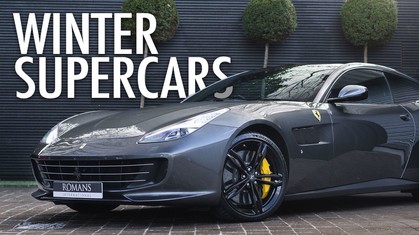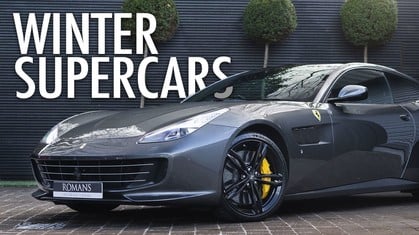5 of the Best Supercars for Winter 2023
As we approach that time of year with darker evenings, frosty mornings and leafless trees, there are still supercars and performance cars that cater more towards comfort, reliability and even off-roading than just sunny Sunday blasts. While many owners are preparing to tuck their pride and joy away in a garage for the coming months, we’ve compiled a list of some of the best supercars you can still enjoy throughout winter.

Porsche 911 Dakar
Fitting more into the sports/performance car category than the supercar category, the Porsche 911 Dakar is still an obvious choice for a fantastic winter car. The performance figures are not dissimilar to a 992 GT3, with the 0-62mph time surprisingly remaining exactly the same at 3.4 seconds. Power sits slightly lower than the GT3 at 473bhp, but still an impressive number for a car built specifically for use offroad and in more extreme conditions.
In 1984 and 1986, Porsche dominated and ultimately won the Paris-Dakar Rally which, you guessed it, was the reason for the 911 Dakar’s name. Being a rally-inspired car meant that the Dakar needed to be able to tackle harsh bumps, muddy terrain and even the most extreme weather conditions, which the German manufacturer achieved with flying colours. A 60mm lift in ride height, which can also increase to 90mm, is the most obvious change over a Carrera 4 GTS on which it’s based, as well as the introduction of Pirelli Scorpion offroad tyres which were developed specifically for Porsche and boast 9mm of tread depth. These tyres sit on a set of brand new Dakar wheels, which are also specifically designed for this car.
Rear-wheel steering comes as standard, along with a plethora of offroad-focused upgrades to the exterior of the car including large tow hooks, a stainless-steel underbody and even a carbon fibre rear wing. But forget the standard features for a moment – the optional extras are where Dakar customers can really start to have fun. There are various rally-inspired liveries and decals available, or if you’re feeling adventurous, there is the ‘Rallye Design Package’ which not only harks back to the aforementioned Paris-Dakar Rally win in 1984 with the two-tone livery and extensive decals.
So while the British roads, fields and hills may not quite be extreme enough to use the Dakar to its full potential, it will certainly take the brunt of what you throw at it, making it perfect for a winter morning blast, tackling slippery B-roads or even just nipping to the shops as, after all, this is still a 911. Porsche’s undeniable, class-leading build quality, reliability and driving feel are all still very much present with the Dakar, but its capability has been turned up a notch or two, creating a fantastic, all-rounder sports car.

Lamborghini Huracan Sterrato
Continuing the theme of rally-inspired supercars, we arrive at a slightly more radical homologation of a “standard” road car – and one which has been in the pipeline for years. What’s not to love when a four-wheel drive, V10-powered, ultra-aggressive supercar is turned into a rally machine? That’s exactly what we have with the Huracan Sterrato.
The Sterrato’s naturally-aspirated V10 engine produces 602bhp – slightly less than its road-going sibling, yet still propels it to 62mph in just 3.4 seconds on the road, with the dirt figure still remaining unknown. Much like the 911 Dakar, the ride height is increased – this time by 44mm for improved ground clearance and adaptability to different terrains. But the biggest aesthetic difference over the standard Huracan and its variants, is a new high-level central air intake, positioned specifically to draw air to the engine without collecting dust, mud and debris which can restrict airflow. This, along with the new optional front fog lights and redesigned alloys make the Sterrato instantly recognisable as no ordinary Huracan.
Many reviews state that the Sterrato is significantly more usable around town than the standard Huracan due to its new ride height and overall suspension setup. Speed bumps, potholes and slippery surfaces – all part and parcel of British winter – are tackled with ease, which is something that is rarely mentioned when talking about a 600bhp+ Lamborghini supercar. While yes, the Sterrato’s purpose is more that of the dust, dirt and snow variety, there is certainly something to be said for a supercar that can handle the more everyday annoyances that wouldn’t be so pleasant usually.
Limited to just 1,499 and representing a dramatic new venture for a supercar brand that has rarely strayed from their tried and tested format, the Sterrato is a fantastic option as a hugely capable, yet surprisingly usable winter supercar.

Audi R8 V10 Performance
We couldn’t write a piece about usable winter supercars without including the Audi R8. With the Audi brand having cemented itself as one of the leaders in reliability, fantastic build quality and everyday usability, those traits continue even through to their supercar. As far as winter supercars go, the R8 boasts a whole host of the necessary requirements; 4-wheel drive, a comfortable and well-built interior, adjustable suspension to allow for the unpredictability of the British roads and let’s not forget; all of the performance and capability you’d expect from Audi’s V10 flagship.
0-62mph is tackled in just 3.2 seconds thanks to the V10’s healthy power figure of 612bhp, and top speed is an impressive 205mph. These figures truly scream value for money when considering the competition at the R8’s price point. Another impressive figure that the R8 achieves is its fuel economy, which sits at 21.7mpg on the combined cycle. While this may not sound to pleasing to someone driving a diesel or electric car every day, for a fully-fledged supercar and when looking at its rivals, these numbers actually seem mighty attractive.
The design of the R8 is familiar and well-loved by customers and fans of the Audi brand, with the interior in particular contributing heavily to our decision to include it in this list. With all of the touch points in the cabin having been crafted to the highest quality, out of solid metals or fine leather, it’s a seriously special, yet user-friendly place to be.
For well over a decade, drivers have been erring towards the R8 as a usable, “dailyable” supercar, and it’s easy to see why. The clever quattro system won’t send you sliding into a ditch (unless you’re really trying). The simplistic-yet-functional design cues throughout the whole car mean it’s stunning, but not shouty. It gets decent fuel economy and because it’s an Audi, and not one of its Italian counterparts, servicing and maintenance won’t cost the Earth, making it a surprisingly sensible choice this winter.

McLaren GT
An unorthodox, yet valid choice for a winter supercar, we’ve chosen the McLaren GT for those who are after the best bits of the 570S or 600LT, with more practicality and usability for daily driving. The GT maintains true supercar performance, with 0-62mph being tackled in 3.2 seconds by the mid-mounted V8 engine which produces 612bhp. With a longer wheelbase than its big brother, the 720S, practicality over other McLaren models is greatly improved, making it a great choice for longer journeys or weekends away. McLaren have made a clear effort to improve the storage space of the McLaren GT, with stowage straps and nets being included for bags or even skis.
McLaren themselves claim that they didn’t want to go down the usual “grand tourer” route of creating a heavy, unresponsive car for the sake of increasing usability. The result of this is the use of a full carbon-fibre Monocell II chassis and Carbon Ceramic brakes which help the GT maintain the handling and performance you’d expect from a McLaren, along with an upgraded ESC (Electronic Stability Control) system to improve stability in all weather conditions.
The interior is instantly recognisable, with the usual sporty feel of McLaren’s sport-series cars. The ‘Luxe Trim’ option drapes the cabin in luxurious Softgrain Aniline leather, along with adding heated comfort seats, ambient lighting and more – all fantastic additions for frosty winter days.
Overall, the McLaren GT is an impressive and ultra-capable grand tourer. With the looks, performance and drama expected of a supercar, it’s hard to believe that this V8 McLaren is as practical, usable and comfortable as it is. If you’re looking to take a winter ski trip where you can travel in style and comfort, while having the option to tackle sweeping European mountain roads with ease, the McLaren GT should absolutely be on your shortlist.

Ferrari GTC4 Lusso
Successor to the FF, and predecessor to the recently unveiled Purosanque, the GTC4 Lusso is the last four-seater, truly practical Ferrari that boasts a traditional supercar design and proportions. With unmistakable Ferrari styling – namely the sweeping, aggressive lines along the body – the Lusso doesn’t deviate far from the usual performance-focused look that a Ferrari provides.
A first for Ferrari, the Lusso was offered with two engine options. A rumbly turbocharged V8 was on the table, along with a screaming naturally aspirated V12 which is the more obvious, and traditional choice. Both of which drive all four wheels, making the Lusso remarkably capable of tackling some of the worst of the UK weather, as well as propelling it off the line in dramatic, blisteringly fast fashion. 0-62mph takes just 3.4 seconds in the V12 and 3.5 seconds in the V8. With the V8 variant weighing a significant 55kg less than the V12, traction is seemingly improved as proven by the almost identical 0-62mph time. The V12 packs a mighty punch at 680bhp, with its V8 counterpart falling nearly 80bhp short, but making up for it with nearly 50lb/ft more torque.
Sporting four seats and a hatchback body style, the Lusso is perfect for everyday chores from taking the kids to school in style, to tackling European mountains and long road trips, with plenty of space for weekend bags. The space in the rear of the cabin is surprisingly large, fitting two adults with ease even for extended trips, albeit with a few stops to stretch the legs. In the front, the usual striking Ferrari design is present, with a large infotainment screen and race-derived controls on the steering wheel.
The V8 variant achieves an average of around 26mpg on the combined cycle, an impressive feat for such a capable supercar, particularly when compared with some of the other choices in this list. The V12, on the other hand, achieves a slightly more meagre figure at just 18.5mpg – but it’s more than made up for if your priority is the drama and noise found in a typical Ferrari engine.
Not only is the GTC4 Lusso four-wheel drive, it also introduces four-wheel steering, adopted from the now legendary F12 TDF. This greatly improves the handling of the Lusso and means that it can tackle even the sharpest of turns with ease. New technology, sporty design and a truly spacious and practical cabin result in a Ferrari that we can confidently say will not need to be tucked away this winter. In fact, the Lusso proves that the Italian marque can create a supercar that still oozes drama and excitement but can also handle daily use and the typical British elements.





